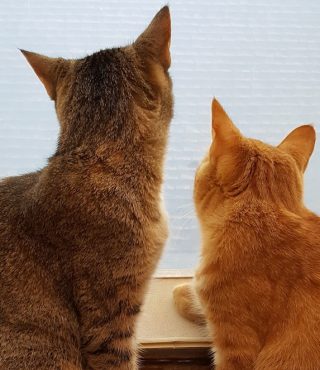The Tail of Two Loves

Ever since I was a young girl, I have been obsessed with cats. My childhood bedroom was covered in cat wallpaper and littered with cat stuffed animals. I was also a big advocate of playing “cats” on the playground during every single recess. In fact, learning about wild cats was my first introduction to the world of biology and that working with animals could, in fact, be a career.
I convinced my mother to get me a cat in elementary school and I’ve lived with cats ever since. My most memorable feline was Millicent, whom we had for 16 years. Millicent was an indoor-outdoor cat, not for any particular reason — that’s just what people did back then. I loved sitting with her in the grass or having her around while I was playing. As I grew older I remember feeling anxiety when I didn’t know where she was. I also remember getting very upset when she came home injured after a run in with another outdoor cat, who was well known around the neighborhood for picking fights. During high school, I realized I wanted to keep Millicent inside, because it would mean she was safe.
During my university career I was introduced to the world of birding. With over 400 breeding birds in Canada, I got hooked on learning anything that I could about them. The more I learnt about birds – and eventually worked with them in my career, — the more I learnt about the troubles they face because of our everyday activities.
Millicent came home every once in a while with a mouse or a bird. At the time, I didn’t think too much of it – after all, it was just a few. Looking back now, I realize the real number was much higher than I thought, since I now know cats only bring back about a quarter of the prey they catch. Had we treated Millicent the same way we treated our dog, a lot of bird, mammal, and probably reptile and amphibian lives would have been spared.
I’ve continued to notice this issue playing out almost everywhere I’ve lived or visited. I’ve seen cats stalking birds in parks and yards, and I had to remove my bird feeders because neighbourhood cats found them and I had exhausted ideas on how to keep my feeder birds safe. It’s frustrating when the decisions of others also affect how you are able to enjoy nature.
Over 100 species of birds are considered At-Risk in Canada, and many more are currently under review. Birds face a wide range of threats such as habitat loss, invasive species, climate change, and pollution. Keep Cats Safe and Save Bird Lives has helped bring a lesser-realized threat, free-roaming cats, to the forefront.
The solutions to these problems can often feel ominous and overwhelming, but it is important that our everyday choices evolve to be environmentally conscious and that we remember that these choices, however small, add up to substantial impact. Of the 130-433 million birds that die per year as a result of people, 75% are estimated to be caused by feral and roaming cats. It’s estimated that a single hunting cat kills an average 16 birds per year: that figure doesn’t include mammals, reptiles, amphibians, or insects, all of which are also experiencing dramatic population declines.
While 16 birds may not seem like much, imagine if every cat owner kept their cat from roaming unsupervised: there would be somewhere between 38 and 133 million more birds in our Canadian skies. The more we regard keeping our cats from roaming unsupervised the same as turning off lights, using less power, buying less meat, purchasing recycled paper, buying organic, or recycling, the more of a difference we can make.
I adopted my current curious feline, Bojangles, in 2017. You may have seen some of his antics on twitter through his account @BojanglesTheKat. While I love showing his hilarious side, I also hope that I will be able to use this account to educate the importance of responsible pet ownership, which includes not allowing your cat to be free roaming outside. Although I still need to constantly remind him he isn’t allowed outside, the satisfaction of knowing that Bo is safe and healthy inside — and that the birds I enjoy outside are safer — is well worth the effort.









